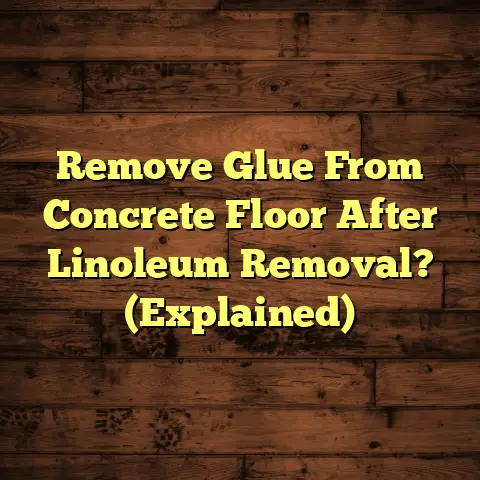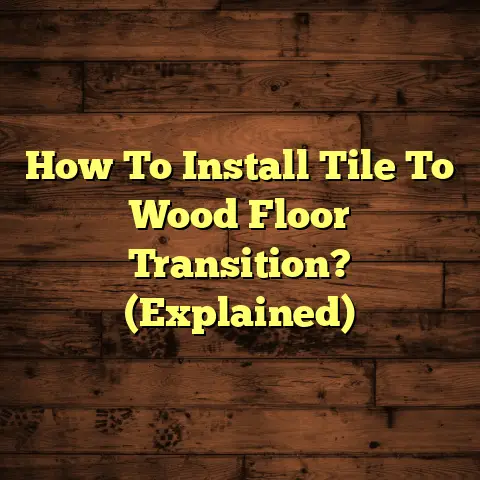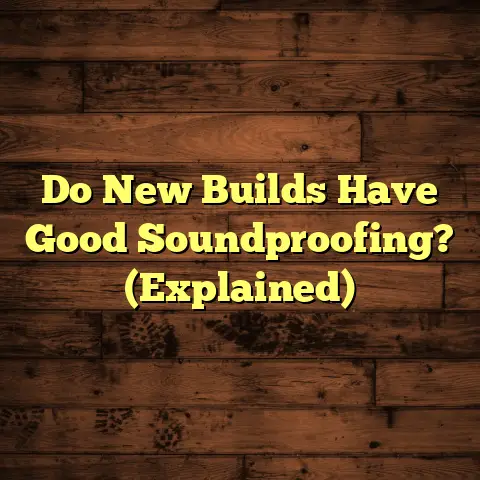Kill Mold On Concrete? (5 Urgent Steps!)
That’s a scary statistic, right? Don’t worry, I’m here to help. I’m going to walk you through the steps you need to take to kill mold on concrete and prevent it from coming back.
Section 1: Understanding Mold Growth on Concrete
Okay, let’s get down to basics. What exactly is mold?
Well, it’s a type of fungus that thrives in damp, dark places.
Think of it like this: mold spores are everywhere, floating around in the air. When they land on a surface with enough moisture and organic material (like dust or dirt), they start to grow. Concrete, being porous, can trap moisture, making it a perfect breeding ground for mold.
There are tons of different types of mold, but some of the most common ones I see on concrete are:
-
Cladosporium: This one’s usually greenish-black and can grow in cool, damp spots.
-
Aspergillus: You might see this one as a variety of colors, and it loves warm, humid conditions.
-
Penicillium: Often bluish-green, this type is a common culprit in water-damaged areas.
Now, why should you care?
Well, besides being unsightly, mold can be a real health hazard. Exposure to mold spores can cause:
-
Allergic reactions: Sneezing, runny nose, itchy eyes, and skin rashes are common.
-
Asthma attacks: Mold can trigger asthma symptoms in people who already have the condition.
-
Respiratory infections: In severe cases, mold exposure can lead to lung infections.
Especially if you have kids, elderly folks, or anyone with respiratory issues in your home, dealing with mold is a must.
Section 2: The Importance of Immediate Action
Let me be blunt: you can’t ignore mold. The longer you let it fester, the worse it gets.
Why is it so urgent to tackle mold on concrete?
First off, mold can weaken the structural integrity of your concrete over time. It can eat away at the surface, causing it to crumble and crack. I’ve seen it happen, and it’s not a pretty sight.
Plus, mold can seriously impact your property value. If you’re planning to sell your home, a mold problem can be a major turnoff for potential buyers. Trust me, a mold inspection is often part of the deal these days.
And here’s another thing: mold spores are like tiny ninjas. They can easily spread to other areas of your home through the air, contaminating carpets, drywall, and even furniture. Before you know it, you’ve got a full-blown mold infestation on your hands.
Don’t wait. Take action ASAP!
Section 3: Step 1 – Identify the Source of Moisture
Alright, time to play detective. The first step in killing mold is figuring out where the moisture is coming from. Remember, mold needs moisture to survive. Cut off the water supply, and you’ll cripple the mold growth.
Where should you look? Here are some common culprits I’ve encountered:
-
Leaks: Check for leaky pipes, faucets, roofs, and windows. Even a small drip can provide enough moisture for mold to thrive.
-
Poor ventilation: Bathrooms, kitchens, and basements are notorious for poor ventilation. If you don’t have proper airflow, moisture can build up quickly.
-
Condensation: This is common on concrete floors and walls, especially in humid climates. When warm, moist air comes into contact with a cold surface, condensation forms, creating a perfect environment for mold.
To get a handle on moisture levels, I recommend using a moisture meter. These handy devices can measure the moisture content of concrete and other materials. You can pick one up at most hardware stores.
If you’re not comfortable doing it yourself, you can always hire a professional mold inspector. They have specialized equipment and expertise to identify hidden moisture sources.
Section 4: Step 2 – Prepare the Area for Cleaning
Okay, you’ve found the moisture source and fixed it. Now it’s time to gear up for the cleaning process. Safety first, folks! Mold can be nasty stuff, so you need to protect yourself.
Here’s what I recommend:
-
Mask: Wear a NIOSH-approved N-95 respirator to prevent inhaling mold spores.
-
Gloves: Use waterproof gloves to protect your skin from direct contact with mold and cleaning solutions.
-
Goggles: Wear safety goggles to shield your eyes from splashes and spores.
-
Ventilation: Open windows and doors to ensure proper ventilation while you’re cleaning. You can also use a fan to circulate air.
Before you start scrubbing, gather your supplies. Here’s a list of essentials:
-
Stiff-bristled brush: This will help you scrub away the mold.
-
Vacuum with HEPA filter: A HEPA filter will trap mold spores and prevent them from being released back into the air.
-
Cleaning solution: I’ll talk more about this in the next section.
-
Spray bottle: For applying the cleaning solution.
-
Clean cloths or sponges: For wiping down the area.
Section 5: Step 3 – Choose the Right Mold Removal Solution
Now, let’s talk about the fun part: choosing the right mold removal solution. You’ve got a few options here, each with its own pros and cons.
-
Commercial Mold Removers: These are specially formulated to kill mold and are available at most hardware stores. Make sure to read the instructions carefully and follow them to the letter.
-
Vinegar: Plain white vinegar is a natural and effective mold killer. It’s also safe and non-toxic. Just spray it on the affected area and let it sit for an hour before wiping it away.
-
Baking Soda: Baking soda is another great natural option. Mix it with water to form a paste, apply it to the mold, and let it dry. Then, scrub it off with a brush.
-
Hydrogen Peroxide: This is a powerful disinfectant that can kill mold on concrete. Spray it on the affected area, let it sit for 10-15 minutes, and then scrub it away.
Important Note: Never mix bleach with ammonia or other cleaning products. This can create toxic fumes that are harmful to your health.
In my experience, vinegar and hydrogen peroxide are pretty effective for mild mold problems. But for more severe infestations, you might need to use a commercial mold remover.
Section 6: Step 4 – Clean the Affected Area
Alright, time to get your hands dirty! Here’s a step-by-step guide to cleaning mold off concrete:
-
Vacuum: Start by vacuuming the affected area with a HEPA-filtered vacuum to remove loose mold spores and debris.
-
Apply Cleaning Solution: Spray your chosen cleaning solution liberally onto the moldy concrete. Make sure to saturate the area thoroughly.
-
Scrub: Use a stiff-bristled brush to scrub the mold off the concrete. Apply firm pressure and work in circular motions.
-
Rinse: Rinse the area with clean water to remove any remaining cleaning solution and mold residue.
-
Dry: This is crucial! Use a clean cloth or towel to dry the area thoroughly. You can also use a fan or dehumidifier to speed up the drying process.
For concrete floors, you can use a mop to apply the cleaning solution and scrub the surface. For walls, you might need to use a sponge or cloth to reach all the nooks and crannies.
If the mold is particularly stubborn, you might need to repeat the cleaning process a few times. Don’t give up!
Section 7: Step 5 – Prevent Future Mold Growth
You’ve killed the mold, but your job isn’t done yet. You need to take steps to prevent it from coming back.
Here are some tips for preventing future mold growth on concrete:
-
Control Moisture: This is the most important thing you can do. Fix any leaks, improve ventilation, and use a dehumidifier to keep humidity levels low.
-
Regular Inspections: Inspect your concrete surfaces regularly for signs of mold growth. The sooner you catch it, the easier it will be to deal with.
-
Clean Regularly: Keep your concrete surfaces clean and free of dust and debris. This will help prevent mold from finding a food source.
-
Seal Concrete: Applying a concrete sealer can help prevent moisture from penetrating the surface.
-
Improve Ventilation: Make sure your bathrooms, kitchens, and basements are well-ventilated. Install exhaust fans or open windows to increase airflow.
I’ve seen people invest in dehumidifiers, especially in basements. It makes a huge difference in keeping the moisture levels down.
Conclusion
So, there you have it! Five urgent steps to kill mold on concrete and prevent it from returning. Remember, mold can be a serious problem, but with the right approach, you can tackle it head-on.
Don’t underestimate the importance of immediate action. The longer you wait, the worse the problem will get. Follow these steps, and you’ll be well on your way to a mold-free home.
Call to Action
Now, I’d love to hear from you! Have you ever dealt with mold issues on concrete? What tips and tricks have you learned along the way? Share your experiences in the comments below!
And if you’re dealing with a particularly extensive or persistent mold problem, don’t hesitate to seek professional assistance. Sometimes, it’s best to call in the experts.
Thanks for reading, and good luck with your mold-fighting endeavors!





